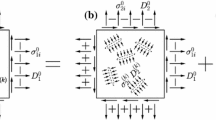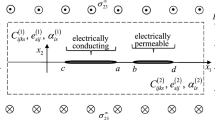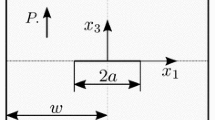Summary
This paper presents a study on the effective electroelastic property of piezoelectric media with parallel or randomly distributed cracks. The theoretical formulation is derived using the dilute model of distributed cracks and the solution of a single dielectric crack problem, in which the electric boundary condition along the crack surfaces is governed by the crack opening displacement. It is observed that the effective electroelastic property of such cracked piezoelectric media is nonlinear and sensitive to loading conditions. Numerical simulations are conducted to show the effects of crack distribution and electric boundary condition upon the effective electroelastic property. The transition between the commonly used electrically permeable and impermeable crack models is studied.
Similar content being viewed by others
References
Kachanov, M.: Effective elastic properties of cracked solids: critical review of some basic concepts. Appl. Mech. Rev. 39, 304–335 (1992).
Kachanov, M.: Elastic solids with many cracks and related problems. Adv. Appl. Mech. 30, 259–428 (1993).
Budiansky, Y., O’Connell, R. J.: Elastic moduli of a cracked solid. Int. J. Solids Struct. 12, 81–92 (1976).
Hori, H., Nemat-Nasser, S.: Overall moduli of solids with microcracks: load-induced anisotropy. J. Mech. Phys. Solids 33, 155–171 (1983).
Norris, A. N.: A differential scheme of the effective moduli of composites. Mech. Mater. 4, 1–16 (1985).
Hashin, Z.: The differential scheme and its application to cracked materials. J. Mech. Phys. Solids 36, 719–734 (1988).
Zimmerman, R. W.: Elastic moduli of a solid containing spherical inclusions. Mech. Mater. 12, 17–24 (1991).
Mori, T., Tanaka, K.: Average stress in matrix and average elastic energy of materials with misfitting inclusions. Acta Metall. 21, 571–574 (1973).
Benveniste, Y.: On the Mori-Tanaka’s method in cracked bodies. Mech. Res. Comm. 13, 193–201 (1986).
Weng, G.: The theoretical connection between Mori-Tanaka’s theory and the Hashin-Shtrikman-Walpole bounds. Int. J. Eng. Sci. 28, 1111–1120 (1990).
Aboudi, J., Benveniste, Y.: The effective moduli of cracked bodies in plane deformations. Eng. Fract. Mech. 26, 171–184 (1987).
Huang, Y., Hu, K. X., Chandra, A.: A generalized self-consistent mechanics method for microcracked solids. J. Mech. Phys. Solids 42, 1273–1291 (1994).
Grekov, A. A., Kramarov, S. O., Kuprienko, A. A.: Effective properties of a transversely isotropic piezocomposite with cylindrical inclusions. Ferroelectrics 99, 115–126 (1989).
Dunn, M. L., Taya, M.: MicroMechanics predictions of the effective electro-elastic moduli of piezoelectric composites. Int. J. Solids Struct. 30, 161–175 (1993).
Chen, T.: Micromechanical estimates of the overall thermoelectricelastic moduli of multiple fibrous composites. Int. J. Solids Struct. 31, 3099–3111 (1994).
Dunn, M. L., Taya, M.: Electromechanical properties of porous piezo-electric ceramics. J. Amer. Ceramics Soc. 76, 1697–1706 (1993).
Yu, S. W., Qin, Q. H.: Damage analysis of thermopiezoelectric properties: Part II. Effective crack model. Theor. Appl. Fract. Mech. 25, 279–288 (1996).
Qin, Q., Mai, Y., Yu, S.: Effective moduli for thermopiezoelectric materials with microcracks. Int. J. Fract. 91, 359–371 (1998).
Parton, V. Z.: Fracture Mechanics piezoelectric materials. Acta Astronaut. 3, 671–683 (1976).
Wang, X. D.: On the dynamic behavior of interacting interfacial cracks in piezoelectric media. Int. J. Solids Struct. 38, 815–831 (2001).
Deeg, W. E. F.: The analysis of dislocation, crack, and inclusion problems in piezoelectric solids. Ph.D thesis, Stanford University, 1980.
Pak, Y. E.: Crack extension force in a piezoelectrical material. J. Appl. Mech. 57, 647–653 (1990).
Suo, Z., Kuo, C. M., Barnett, D. M., Willis, J. R.: Fracture mechanics for pieozoelectric ceramics. J. Mech. Phys. Solids 40, 739–765 (1992).
Park, S., Sun, C. T.: Fracture criteria for piezoelectric ceramics. J. Amer. Ceramic Soc. 78, 1475–1480 (1995).
McMeeking, R. M.: Electrostrictive stresses near crack-like flaws. J. Appl. Math. Phys. 40, 615–627 (1989).
Sosa, H.: Plane problems in piezoelectric media with defects. Int. J. Solids Struct. 28, 491–505 (1991).
Dunn, M. L.: The effects of crack face boundary conditions on the fracture mechanics piezoelectric solids. Eng. Fract. Mech. 48, 25–39 (1994).
Zhang, T. Y., Qian, C. F., Tong, P.: Linear electro-elastic analysis of a cavity or a crack in a piezoelectric material. Int. J. Solids Struct. 35, 2121–2149 (1996).
Wang, X. D., Jiang, L. Y.: Fracture behavior of cracks in piezoelectric media with electromechanically coupled boundary conditions. Proc. Royal Soc. London A 458, 2545–2560 (2002).
Xu, X. L., Rajapakse, R. K. N. D.: On a plane crack in piezoelectric solids. Int. J. Solids Struct. 38, 7643–7658 (2001).
Wang, X. D., Jiang, L. Y.: The effective electroelastic property of piezoelectric media with parallel dielectric cracks. Int. J. Solids Struct. 40, 5287–5303 (2003).
Nemat-Nasser, S., Hori, M.: MicroMech: overall properties of heterogeneous materials. Amsterdam: North-Holland 1993.
Tsukrov, I., Kachanov, M.: Effective moduli of an anisotropic material with elliptical holes of arbitrarily orientational distribution. Int. J. Solids Struct. 37, 5919–5941 (2000).
Bristow, J. R.: Microcracks and the static and dynamic elastic constants of annealed and heavily cold-worked metals. Brit. J. Appl. Phys. 11, 81–85 (1960).
Author information
Authors and Affiliations
Corresponding author
Rights and permissions
About this article
Cite this article
Wang, X.D., Jiang, L.Y. The effective electroelastic property of cracked piezoelectric media. Acta Mechanica 177, 97–113 (2005). https://doi.org/10.1007/s00707-005-0226-2
Received:
Accepted:
Published:
Issue Date:
DOI: https://doi.org/10.1007/s00707-005-0226-2




